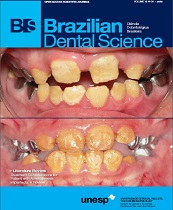Effect of root perforations on the bond strength of fiberglass post using different adhesive systems and resin cement
DOI:
https://doi.org/10.14295/bds.2013.v16i4.940Resumo
Objective: This study evaluated the effect of rootperforations on the bond strength of fiberglassposts cemented to the root canal with two adhesivesystems and resin cement. Material and Methods:Forty single-rooted human teeth received endodontictreatment and were prepared for the cementationof fiberglass posts (Exacto Mini, Angelus). Theteeth were divided into four experimental groups(n = 10) according to the root condition (with orwithout perforation) and the adhesive system used:G1: without perforation + Adper Single Bond 2(3M ESPE), G2: without perforation + Clearfil SEBond (Kuraray), G3: with perforation + AdperSingle Bond 2, G4: with perforation + Clearfil SEBond. The perforation was executed on the rootsurface with a diamond bur and sealed with whitemineral trioxide aggregate (MTA). The specimenswere sectioned and a push-out test was carriedout (1 mm/min speed and 50 kgf). The data werestatistically analyzed by ANOVA and Tukey Test(5%). Results: Adper Single Bond 2 promoted thegreatest values of bond strength to the roots withoutroot perforation. The presence of root perforation ledto the reduction in bond strength values regardlessof the bonding system used (p < 0.05). Conclusion:The root perforations caused a direct effect on thebond strength of the fiberglass posts cemented byreducing the bond strength values to the root dentinregardless of the adhesive system used.
Keywords
Adhesion; Cementation; Dental adhesives; Dental cements; Fiberglass pins.
Downloads
Downloads
Publicado
Como Citar
Edição
Seção
Licença
TRANSFERÊNCIA DE DIREITOS AUTORAIS E DECLARAÇÃO DE RESPONSABILIDADE
Toda a propriedade de direitos autorais do artigo "____________________________________________________________________" é transferido do autor(es) para a CIÊNCIA ODONTOLÓGICA BRASILEIRA, no caso do trabalho ser publicado. O artigo não foi publicado em outro lugar e não foi submetido simultaneamente para publicação em outra revista.
Vimos por meio deste, atestar que trabalho é original e não apresenta dados manipulados, fraude ou plágio. Fizemos contribuição científica significativa para o estudo e estamos cientes dos dados apresentados e de acordo com a versão final do artigo. Assumimos total responsabilidade pelos aspectos éticos do estudo.
Este texto deve ser impresso e assinado por todos os autores. A versão digitalizada deverá ser apresentada como arquivo suplementar durante o processo de submissão.




























